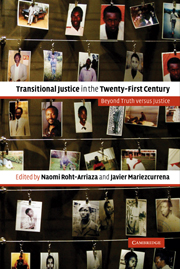Book contents
- Frontmatter
- Contents
- List of contributors
- Acknowledgments
- The new landscape of transitional justice
- Part I Truth, justice, and multiple institutions
- Introduction to Part I
- 1 The Sierra Leone Truth and Reconciliation Commission
- 2 Transitional criminal justice in Sierra Leone
- 3 The Peruvian Truth and Reconciliation Commission and the challenge of impunity
- 4 The “Mexican solution” to transitional justice
- 5 No justice, no peace: Discussion of a legal framework regarding the demobilization of non-state armed groups in Colombia
- 6 Hybrid attempts at accountability for serious crimes in Timor Leste
- Part II Levels of justice: Local, national and international
- Index
4 - The “Mexican solution” to transitional justice
Published online by Cambridge University Press: 05 June 2012
- Frontmatter
- Contents
- List of contributors
- Acknowledgments
- The new landscape of transitional justice
- Part I Truth, justice, and multiple institutions
- Introduction to Part I
- 1 The Sierra Leone Truth and Reconciliation Commission
- 2 Transitional criminal justice in Sierra Leone
- 3 The Peruvian Truth and Reconciliation Commission and the challenge of impunity
- 4 The “Mexican solution” to transitional justice
- 5 No justice, no peace: Discussion of a legal framework regarding the demobilization of non-state armed groups in Colombia
- 6 Hybrid attempts at accountability for serious crimes in Timor Leste
- Part II Levels of justice: Local, national and international
- Index
Summary
The political context for human rights and the Mexican transition to democracy
The legacy of a repressive regime
The current government of Mexico, led by Vicente Fox, came to power thanks to the first truly democratic and competitive national election held in the past 90 years. The vote that resulted in his victory in the year 2000 ended the 71-year-old monopoly of state power held by the Institutional Revolutionary Party (Partido Revolucionario Institucional – PRI) since 1929, when it was founded by a coalition of caudillos and revolutionary generals after two decades of revolution and civil war.
The very fact that the Mexican electorate was able to produce such a result was the product of generations of struggle. It was also the first time in the history of the country that political change did not result from the use of violence and bloodshed, but was carried out by the peaceful exercise of political rights. This in itself is no small matter, but a fact which tends to be overlooked, given the stable nature of Mexico's protracted authoritarian regime. The election that brought Vicente Fox, a candidate of the center-right opposition party, National Action Party (Partido Acción Nacional – PAN) to power, was the result of the consistent and peaceful mobilization of thousands of people for the effective exercise of civil and political rights, and especially for the basic right to participate in free, fair and authentic elections. This fact makes it an historic turning point of great significance.
- Type
- Chapter
- Information
- Transitional Justice in the Twenty-First CenturyBeyond Truth versus Justice, pp. 94 - 119Publisher: Cambridge University PressPrint publication year: 2006
- 12
- Cited by



